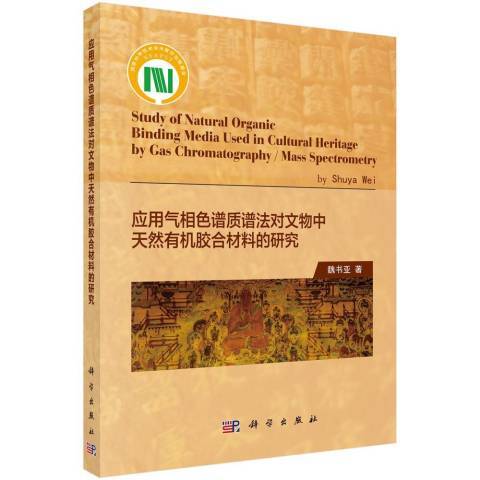《套用氣相色譜質譜法對文物中天然有機膠合材料的研究》是2021年科學出版社出版的圖書。
基本介紹
- 中文名:套用氣相色譜質譜法對文物中天然有機膠合材料的研究
- 作者:魏書亞
- 出版社:科學出版社
- 出版時間:2021年7月1日
- 開本:16 開
- 裝幀:平裝
- ISBN:9787030671554
內容簡介,圖書目錄,
內容簡介
用於裝飾目的的顏料可以追溯到4萬年前,當時史前人類用繪畫和素描裝飾洞穴。古時候可用油、樹脂、阿拉伯樹膠、明膠、蛋清、蜂蠟等作為黏結劑。顯然,這些有機材料在藝術史上起著非常重要的作用,因此,對其進行明確的識別和更好地了解其退化機制,對於保護文化遺產至關重要。本《套用氣相色譜質譜法對文物中天然有機膠合材料的研究》研究了GC/MS和Py-GC/MS技術來鑑定藝術品中套用,並以案例形式介紹了其使用方法。
圖書目錄
Contents
Chapter 1 Introduction to gas chromatography and mass spectrometry 1
1.1 Gas chromatography 1
1.2 Mass spectrometry 1
1.3 The Components and functions of GC/MS 3
1.3.1 Ion source 3
1.3.2 Mass analyzer 3
1.3.3 Detector 4
1.4 Pyrolysis with gas chromatography and mass spectrometry (Py-GC/MS) 4
References 5
Chapter 2 Overview about the natural organic binding media used in artworks 6
2.1 Introduction 6
2.2 Oils as binding media 9
2.2.1 The identification of oils 9
2.2.2 The drying and degradation of oils as binding media 11
2.3 Proteinaceous materials as binding media 13
2.3.1 Structure of protein and amino acids 13
2.3.2 Techniques for protein analysis 13
2.3.3 Drying and degradation processes of proteinaceous binding media 15
2.4 Resins used in artworks 16
2.4.1 Diterpenic resins 18
2.4.2 Triterpenoid resin 20
2.5 Waxes 22
2.5.1 Waxes from animal origins 22
2.5.2 Waxes from plant origins 23
2.5.3 Waxes from mineral origins 23
2.5.4 The analytical techniques used for analysis of waxes 24
2.5.5 The alteration of waxes during ageing 24
2.6 Aims of this research 25
References 25
Chapter 3 The influence of different pigments to the degradation and the identification of oils as binding media in artworks 31
3.1 Introduction 31
3.1.1 The use of oils as binding medium 31
3.1.2 The effects of pigments on drying and degradation of oil binding media 33
3.2 The experiment part 34
3.2.1 Apparatus 34
3.2.2 The mock-ups 34
3.2.3 The accelerating settings 36
3.2.4 Sample preparation procedure for GC/MS analysis 36
3.2.5 Calibration of the fatty acids 36
3.3 Results and discussions 38
3.3.1 Analysis results for fresh oils and artificially aged samples 38
3.3.2 Investigation of the P/S ratio of paint samples with different pigment during the ageing process 39
3.3.3 Marker compounds and indicative ranges for degradation products (Su/A, A/P) 42
3.3.4 O/P ratios in mock-ups with different pigments during ageing process 44
3.3.5 Evaluating the absolute amounts of detectable fatty acids in mock-ups during ageing process 45
3.3.6 Analysis results from poppy seed oil and walnut oil 48
3.4 Discussions 49
References 50
3.5 Case study 52
3.5.1 Characterization of Tang Dynasty lamp oil remains by using pyrolysis gas chromatography and mass spectrometry 52
3.5.2 The identification of binding agent used in late Shang Dynasty turquoise-inlayed bronze objects excavated in Anyang 66
Chapter 4 The study of proteinaceous materials used in artworks 81
4.1 Introduction 81
4.2 Chosen methodology for this study 83
4.3 Mock-ups and accelerated ageing procedures 84
4.4 Chemicals 85
4.5 Experimental part 85
4.5.1 Analytical equipment and conditions 85
4.5.2 Derivatization procedure by using ECF 86
4.6 Results and discussions 88
4.6.1 Characterisation of un-pigmented mock-ups by GC/MS 88
4.6.2 Characterisation of UV3 aged mock-ups of whole egg as binder with different pigments 91
4.6.3 Characterisation of the lipid fraction of proteinaceous materials 91
4.7 Conclusions 93
Reference 94
4.8 Case study 95
4.8.1 Scientific investigation of the paint and adhesive materials used in the Western Han Dynasty polychromy terracotta army, Qingzhou, China 95
4.8.2 Scientific investigation of the materials in a Chinese Ming Dynasty wall painting 108
4.8.3 Characterization of the materials used in Chinese ink sticks by pyrolysis- gas chromatography-mass spectrometry 124
4.8.4 Identification of the materials used in an Eastern Jin Chinese ink stick 136
Chapter 5 The identification of resins used in artworks and their chemical changes during ageing processes 147
5.1 Introduction 147
5.1.1 Mock-ups prepared in the Art History Museum, Vienna 148
5.1.2 Paint samples with mixed binding media 149
5.1.3 Samples from historic paintings 149
5.1.4 Artificial ageing experiments 149
5.2 Experiment part 149
5.2.1 Instrumental conditions 149
5.2.2 Sample preparation for GC/MS analysis 150
5.3 Results and discussions 150
5.3.1 Copal and sandarac resins 150
5.3.2 Baltic Amber 152
5.3.3 Mastic and dammar 154
5.3.4 Characterisation of samples with mixed binding media 156
5.3.5 Qualitative analysis: results and discussion 157
5.3.6 Investigating chemical changes of mixed binding media during ageing 161
5.3.7 Characterization of binding media from real paintings 164
5.4 Conclusions 167
References 168
5.5 Case study 169
5.5.1 The study of binding agents used to inlay turquoise onto bronze objects in Eastern Zhou Dynasty 169
5.5.2 The identification of the binding media in the Tang Dynasty Chinese wall painting by using Py-GC/MS and GC/MS techniques 177
Chapter 6 Study of the effects of pigments and ageing to the identification of waxes used in artworks 192
6.1 Introduction 192
6.2 Experimental part 1

